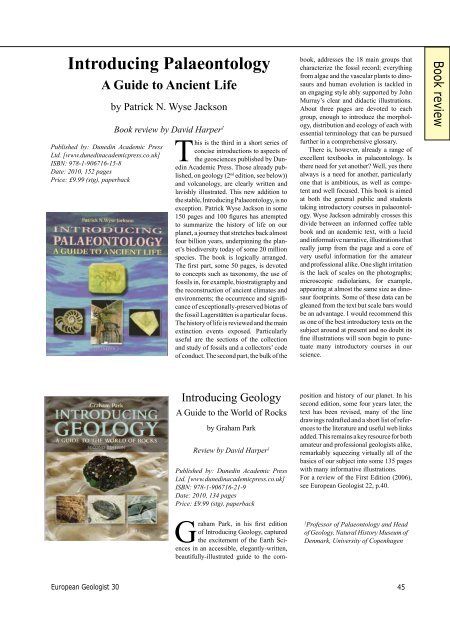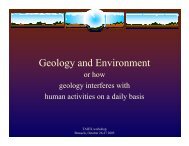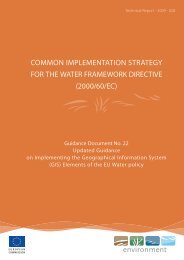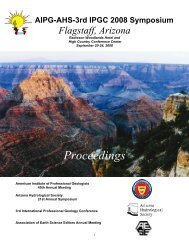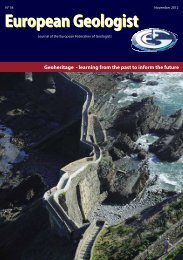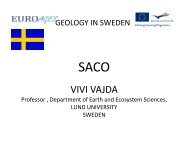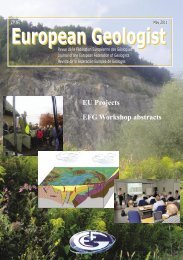EGM 30 download.pdf - European Federation of Geologists
EGM 30 download.pdf - European Federation of Geologists
EGM 30 download.pdf - European Federation of Geologists
You also want an ePaper? Increase the reach of your titles
YUMPU automatically turns print PDFs into web optimized ePapers that Google loves.
Introducing PalaeontologyA Guide to Ancient LifePublished by: Dunedin Academic PressLtd. [www.dunedinacademicpress.co.uk]ISBN: 978-1-906716-15-8Date: 2010, 152 pagesPrice: £9.99 (stg), paperbackby Patrick N. Wyse JacksonBook review by David Harper 1This is the third in a short series <strong>of</strong>concise introductions to aspects <strong>of</strong>the geosciences published by DunedinAcademic Press. Those already published,on geology (2 nd edition, see below))and volcanology, are clearly written andlavishly illustrated. This new addition tothe stable, Introducing Palaeontology, is noexception. Patrick Wyse Jackson in some150 pages and 100 figures has attemptedto summarize the history <strong>of</strong> life on ourplanet, a journey that stretches back almostfour billion years, underpinning the planet’sbiodiversity today <strong>of</strong> some 20 millionspecies. The book is logically arranged.The first part, some 50 pages, is devotedto concepts such as taxonomy, the use <strong>of</strong>fossils in, for example, biostratigraphy andthe reconstruction <strong>of</strong> ancient climates andenvironments; the occurrence and significance<strong>of</strong> exceptionally-preserved biotas <strong>of</strong>the fossil Lagerstätten is a particular focus.The history <strong>of</strong> life is reviewed and the mainextinction events exposed. Particularlyuseful are the sections <strong>of</strong> the collectionand study <strong>of</strong> fossils and a collectors’ code<strong>of</strong> conduct. The second part, the bulk <strong>of</strong> thebook, addresses the 18 main groups thatcharacterize the fossil record; everythingfrom algae and the vascular plants to dinosaursand human evolution is tackled inan engaging style ably supported by JohnMurray’s clear and didactic illustrations.About three pages are devoted to eachgroup, enough to introduce the morphology,distribution and ecology <strong>of</strong> each withessential terminology that can be pursuedfurther in a comprehensive glossary.There is, however, already a range <strong>of</strong>excellent textbooks in palaeontology. Isthere need for yet another? Well, yes therealways is a need for another, particularlyone that is ambitious, as well as competentand well focused. This book is aimedat both the general public and studentstaking introductory courses in palaeontology.Wyse Jackson admirably crosses thisdivide between an informed c<strong>of</strong>fee tablebook and an academic text, with a lucidand informative narrative, illustrations thatreally jump from the page and a core <strong>of</strong>very useful information for the amateurand pr<strong>of</strong>essional alike. One slight irritationis the lack <strong>of</strong> scales on the photographs;microscopic radiolarians, for example,appearing at almost the same size as dinosaurfootprints. Some <strong>of</strong> these data can begleaned from the text but scale bars wouldbe an advantage. I would recommend thisas one <strong>of</strong> the best introductory texts on thesubject around at present and no doubt itsfine illustrations will soon begin to punctuatemany introductory courses in ourscience.Book reviewIntroducing GeologyA Guide to the World <strong>of</strong> Rocksby Graham ParkReview by David Harper 1Published by: Dunedin Academic PressLtd. [www.dunedinacademicpress.co.uk]ISBN: 978-1-906716-21-9Date: 2010, 134 pagesPrice: £9.99 (stg), paperbackposition and history <strong>of</strong> our planet. In hissecond edition, some four years later, thetext has been revised, many <strong>of</strong> the linedrawings redrafted and a short list <strong>of</strong> referencesto the literature and useful web linksadded. This remains a key resource for bothamateur and pr<strong>of</strong>essional geologists alike,remarkably squeezing virtually all <strong>of</strong> thebasics <strong>of</strong> our subject into some 135 pageswith many informative illustrations.For a review <strong>of</strong> the First Edition (2006),see <strong>European</strong> Geologist 22, p.40.Graham Park, in his first edition<strong>of</strong> Introducing Geology, capturedthe excitement <strong>of</strong> the Earth Sciencesin an accessible, elegantly-written,beautifully-illustrated guide to the com-1Pr<strong>of</strong>essor <strong>of</strong> Palaeontology and Head<strong>of</strong> Geology, Natural History Museum <strong>of</strong>Denmark, University <strong>of</strong> Copenhagen<strong>European</strong> Geologist <strong>30</strong>45


